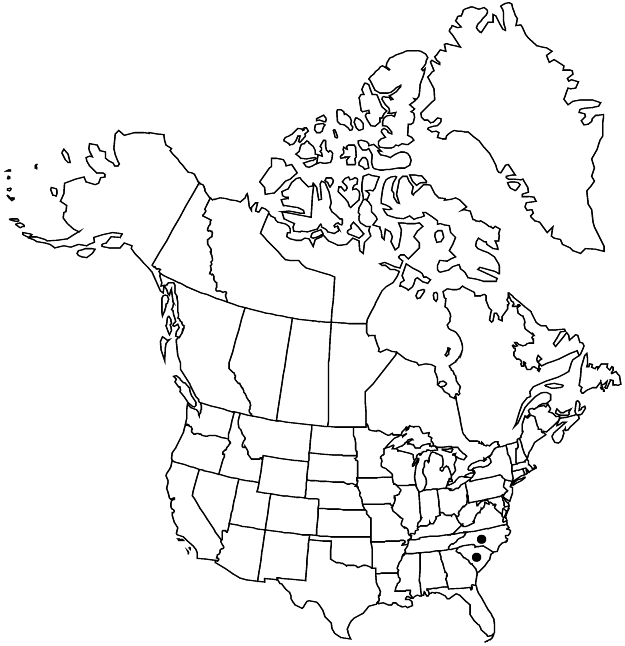Sarracenia jonesii
J. Wash. Acad. Sci. 19: 385, fig. p. 387. 1929,.
Plants forming dense clumps; rhizomes 0.5–1.5 cm diam. Pitchers persistent, appearing with flowers, producing similar pitchers through summer, erect, (long-petiolate, basal 1/4–1/3 of tube solid, without open cavity, tapering distally to form hollow tube and distinctly bulging abaxially mostly in distal 1/4 of tube), green, usually reddish or purple-veined adaxially, rarely with an overall deep maroon-purple suffusion, without white areolae, 21–73 cm, firm, waxy, external surface glabrous, wings 0.2–1 (–1.5) cm wide; orifice oval, 1–4 cm diam., rim maroon, tightly revolute, usually with slight to distinct indentation distal to wing often forming conspicuous spout extending over wing; hood recurved adaxially, held well beyond and covering orifice, red-purple, veins on adaxial and abaxial surfaces distinctive, red-purple throughout, without white areolae, broadly ovate, undulate, 2.4–6.5 × 2.4–5.4 cm, longer than wide, base cordate, neck not constricted, 0.5–1 cm, apiculum 1–4 mm, adaxial surface glabrate or with hairs to 0.5 mm. Phyllodia absent. Scapes 1–2, 32–70 cm, rarely exceeding tallest pitchers; bracts 1–2 cm. Flowers moderately fragrant; sepals maroon, 2.5–3.5 × 1.5–2 cm; petals maroon, distal portion obovate, 2.5–4 × 1.2–2.8 cm, margins erose; style disc green, 2.5–4 cm diam. Capsules 0.6–1.2 cm diam. Seeds 1.2–1.5 mm. 2n = 26.
Phenology: Flowering May.
Habitat: Mountain seepage bogs
Elevation: 300-600 m
Discussion
Of conservation concern.
Sarracenia jonesii occurs in seepage bogs in the low mountains in southwestern North Carolina (Buncombe, Henderson, and Transylvania counties) and in seeps along gentle waterfalls on the adjacent South Carolina Blue Ridge escarpment (Greenville and Pickens counties). Within its native range, populations have been introduced and naturalized. It can form clumps to 0.5 m across in meadowlike seepage bogs. It is rare and vulnerable. Most of its prime locations have disappeared since 1950 due to development. It is federally listed as endangered and worthy of managed protection. Anthocyanin-free plants, with yellowish-green flowers and pitchers, are known in the wild. Plants from some locations can be vegetatively similar to other members of the S. rubra complex from the fall line of South Carolina or the Gulf Coast, or even some plants of S. alata hybrids west of Mobile Bay, Alabama, with bulges in the distal portions of their tubes. Always check the largest, well-grown pitchers for traits, and correlate with floral characters. Sarracenia jonesii is readily distinguished from S. rubra by its longer, solid petioles and scapes about as long as the pitchers.
Sarracenia jonesii is in the Center for Plant Conservation’s National Collection of Endangered Plants.
Selected References
None.
Lower Taxa
"winged" is not a number."variable" is not a number.
